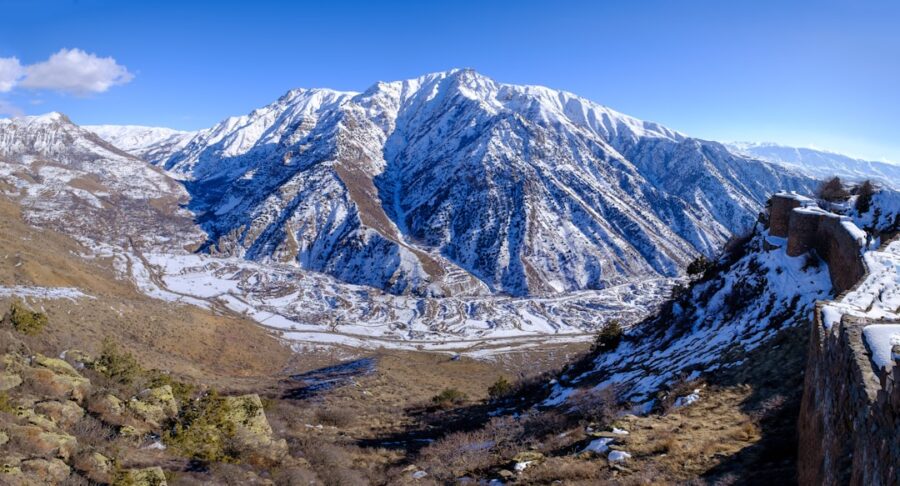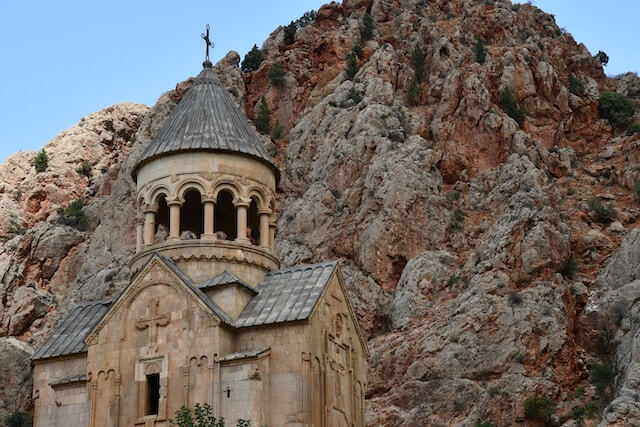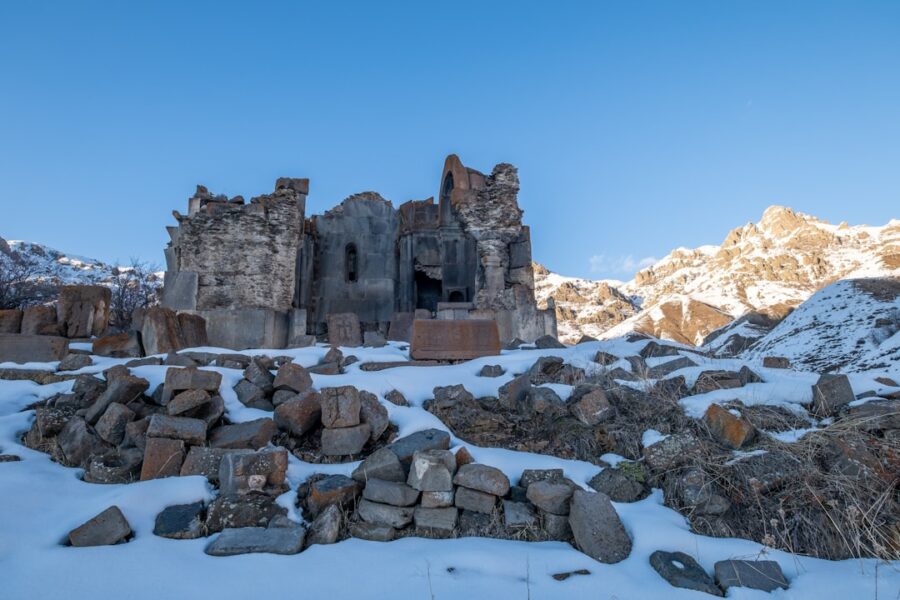Armenia, a land steeped in ancient history and dramatic landscapes, holds countless treasures waiting to be discovered. While well-known landmarks like Geghard Monastery and Lake Sevan often steal the spotlight, a truly enchanting experience awaits those who venture off the beaten path to explore the Smbataberd Fortress Armenia. This formidable medieval stronghold, perched high on a ridge overlooking the picturesque village of Yeghegis, offers breathtaking panoramic views and a captivating glimpse into Armenia’s rich past. Prepare to be transported back in time as we delve into the history, architecture, and practicalities of visiting this hidden gem.
A Journey Through Time: The History of Smbataberd

The history of Smbataberd Fortress Armenia is interwoven with the rise and fall of powerful Armenian dynasties. While the exact origins of the fortress remain somewhat shrouded in mystery, historians generally agree that the site was initially fortified in the 5th century AD. However, it was during the reign of the Syuni dynasty, particularly under King Smbat II in the 10th century, that Smbataberd truly flourished and gained its current imposing form. The fortress served as a crucial strategic point, guarding the vital trade routes that traversed the region and providing refuge for the local population during times of conflict.
The Syuni dynasty, known for its patronage of the arts and sciences, transformed Smbataberd into a formidable military and administrative center. The fortress walls were reinforced, new towers were added, and sophisticated water management systems were implemented to ensure the long-term survival of the garrison. Within the walls, a bustling community thrived, complete with churches, residences, and workshops. Smbataberd became a symbol of Syuni power and resilience.
Unfortunately, the golden age of Smbataberd was not destined to last forever. In the 13th century, the Mongol invasions swept across Armenia, leaving a trail of destruction in their wake. While Smbataberd managed to withstand the initial onslaught, it eventually fell under Mongol control. The fortress gradually lost its strategic importance and was eventually abandoned, falling into disrepair and succumbing to the ravages of time. Despite its abandonment, the imposing ruins of Smbataberd Fortress Armenia continue to inspire awe and wonder, offering a tangible link to Armenia’s medieval past.
Architectural Marvel: Exploring the Fortress Walls and Towers
The architecture of Smbataberd Fortress Armenia is a testament to the ingenuity and skill of medieval Armenian builders. The fortress is strategically situated on a narrow ridge, surrounded by steep cliffs on three sides, providing a natural defense against potential attackers. The remaining side, which is more vulnerable, is protected by a massive curtain wall, reinforced by several imposing towers. These towers, strategically positioned to provide overlapping fields of fire, allowed the defenders to effectively repel any attempts to breach the fortress.
The walls of Smbataberd are constructed from locally sourced basalt stones, carefully fitted together to create a strong and durable barrier. The sheer size and thickness of the walls are impressive, reflecting the importance of the fortress as a defensive stronghold. Walking along the ramparts, you can appreciate the scale of the construction and imagine the challenges faced by the builders.
Within the fortress walls, you can still discern the outlines of various buildings, including churches, residences, and storage facilities. While many of these structures are now in ruins, they provide valuable insights into the daily life of the people who once lived and worked within the fortress. The remains of a sophisticated water system, including underground cisterns and aqueducts, are also visible, highlighting the advanced engineering capabilities of the time.
Key Architectural Features:
- Massive Curtain Walls: Constructed from basalt, providing a formidable defensive barrier.
- Strategic Towers: Positioned to provide overlapping fields of fire, maximizing defensive capabilities.
- Ruined Churches: Evidence of the religious life within the fortress.
- Residential Structures: Outlines of houses and other dwellings, offering glimpses into daily life.
- Water Management System: Underground cisterns and aqueducts, demonstrating advanced engineering skills.
Planning Your Visit: Practical Tips and Actionable Advice
Visiting Smbataberd Fortress Armenia is an unforgettable experience, but careful planning is essential to ensure a smooth and enjoyable trip. Here are some practical tips and actionable advice to help you make the most of your visit:
Getting There:
Smbataberd is located near the village of Yeghegis, in the Vayots Dzor province of Armenia. The most convenient way to reach the fortress is by car or taxi. If you are driving, be aware that the road leading to Yeghegis can be quite rough in places, so a vehicle with good ground clearance is recommended. Alternatively, you can hire a taxi from the nearby town of Yeghegnadzor.
Another option is to take a marshrutka (minibus) from Yerevan to Yeghegnadzor and then hire a taxi to take you to Yeghegis and the fortress. However, this option may be less convenient and time-consuming.
Best Time to Visit:
The best time to visit Smbataberd Fortress Armenia is during the spring (April-June) or autumn (September-October) months. The weather during these periods is generally mild and pleasant, making it ideal for hiking and exploring the outdoors. Summer can be quite hot, especially during midday, so it’s important to bring plenty of water and sunscreen. Winter can be cold and snowy, making access to the fortress more challenging.
What to Wear and Bring:
- Comfortable Walking Shoes: The terrain around the fortress is uneven and rocky, so sturdy walking shoes are essential.
- Sunscreen and Hat: The sun can be strong, especially during the summer months.
- Water: It’s important to stay hydrated, especially if you are hiking.
- Snacks: There are no facilities for buying food or drinks at the fortress, so bring your own snacks.
- Camera: You’ll want to capture the stunning views and historical architecture.
- Layers of Clothing: The weather can change quickly, so it’s a good idea to bring layers of clothing.
Things to Do:
- Explore the Fortress Walls and Towers: Take your time to explore the ramparts and towers, admiring the architecture and panoramic views.
- Hike to the Fortress: Enjoy a scenic hike from Yeghegis to the fortress, taking in the beautiful landscapes along the way.
- Visit the Nearby Noravank Monastery: Combine your visit to Smbataberd with a trip to the stunning Noravank Monastery, another of Armenia’s architectural gems.
- Explore Yeghegis Village: Discover the charming village of Yeghegis, with its traditional houses and friendly locals.
- Picnic with a View: Find a scenic spot near the fortress and enjoy a picnic lunch with breathtaking views of the surrounding countryside.
Safety Tips:
- Be Aware of the Terrain: The terrain around the fortress can be uneven and rocky, so watch your step.
- Stay on Marked Paths: Stick to the marked paths to avoid getting lost or injured.
- Inform Someone of Your Plans: Let someone know where you are going and when you expect to be back.
- Be Respectful of the Site: Treat the historical site with respect and avoid damaging any of the structures.
- Check the Weather Forecast: Check the weather forecast before you go and be prepared for changing conditions.
Beyond the Walls: Exploring the Surrounding Region
A visit to Smbataberd Fortress Armenia is not just about exploring the fortress itself; it’s also an opportunity to discover the beauty and charm of the surrounding region. Vayots Dzor province is known for its stunning landscapes, ancient monasteries, and delicious local cuisine. Here are some of the highlights:
Noravank Monastery:

Located a short drive from Yeghegis, Noravank Monastery is one of Armenia’s most iconic landmarks. This stunning monastery, nestled in a narrow gorge, is renowned for its intricate carvings and beautiful red rock formations. Don’t miss the opportunity to explore this architectural masterpiece.
Areni Wine Region:

Vayots Dzor is also famous for its wine production, particularly the Areni grape variety. Visit one of the local wineries and sample some of Armenia’s finest wines. The Areni region is also home to the Areni-1 cave, where the world’s oldest known winery was discovered.
Yeghegis Village:

Take some time to explore the charming village of Yeghegis, with its traditional houses, friendly locals, and ancient churches. The village is a great place to experience authentic Armenian culture and hospitality.
Shatin Village and the Yeghegis Gorge:
The Yeghegis Gorge is a beautiful natural wonder, offering stunning views and opportunities for hiking and exploring. The village of Shatin, located at the entrance to the gorge, is known for its traditional Armenian architecture and friendly atmosphere. Keep an eye out for the Bezoar goats that frequent the cliffs of the gorge!
Smbataberd Fortress Armenia: A Timeless Treasure

Smbataberd Fortress Armenia is more than just a collection of ancient stones; it’s a living testament to Armenia’s rich history, resilience, and enduring spirit. A visit to this enchanting fortress is an unforgettable journey back in time, offering breathtaking views, captivating architecture, and a profound sense of connection to the past. So, venture off the beaten path and discover the magic of Smbataberd – a hidden gem that will leave you spellbound.
By following the practical tips and actionable advice outlined in this guide, you can ensure a safe, enjoyable, and enriching experience. Prepare to be amazed by the beauty, history, and cultural significance of Smbataberd Fortress Armenia, a destination that truly embodies the spirit of adventure and discovery.
Remember to respect the site, pack accordingly, and be prepared for an unforgettable journey into Armenia’s captivating past. Happy travels!


